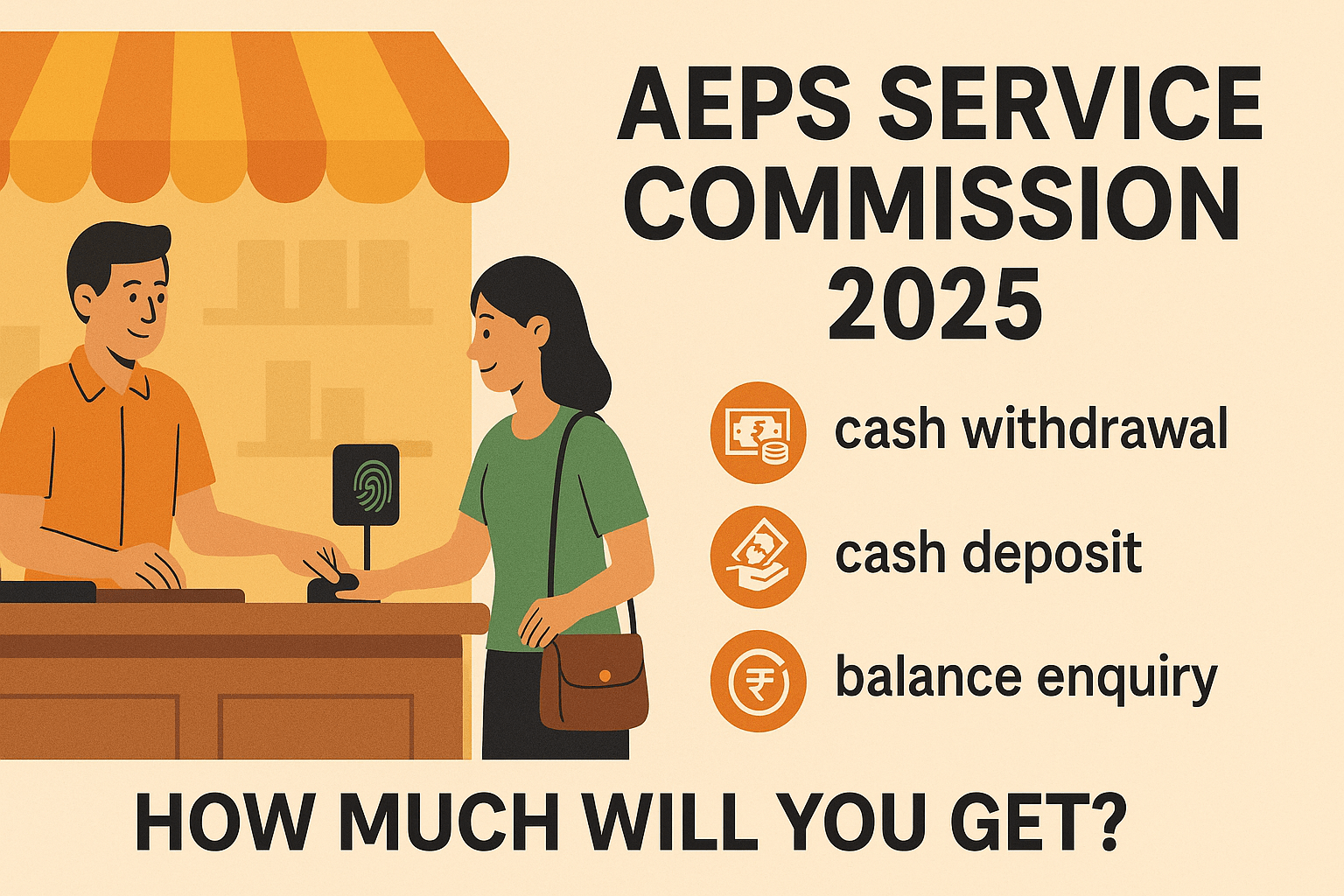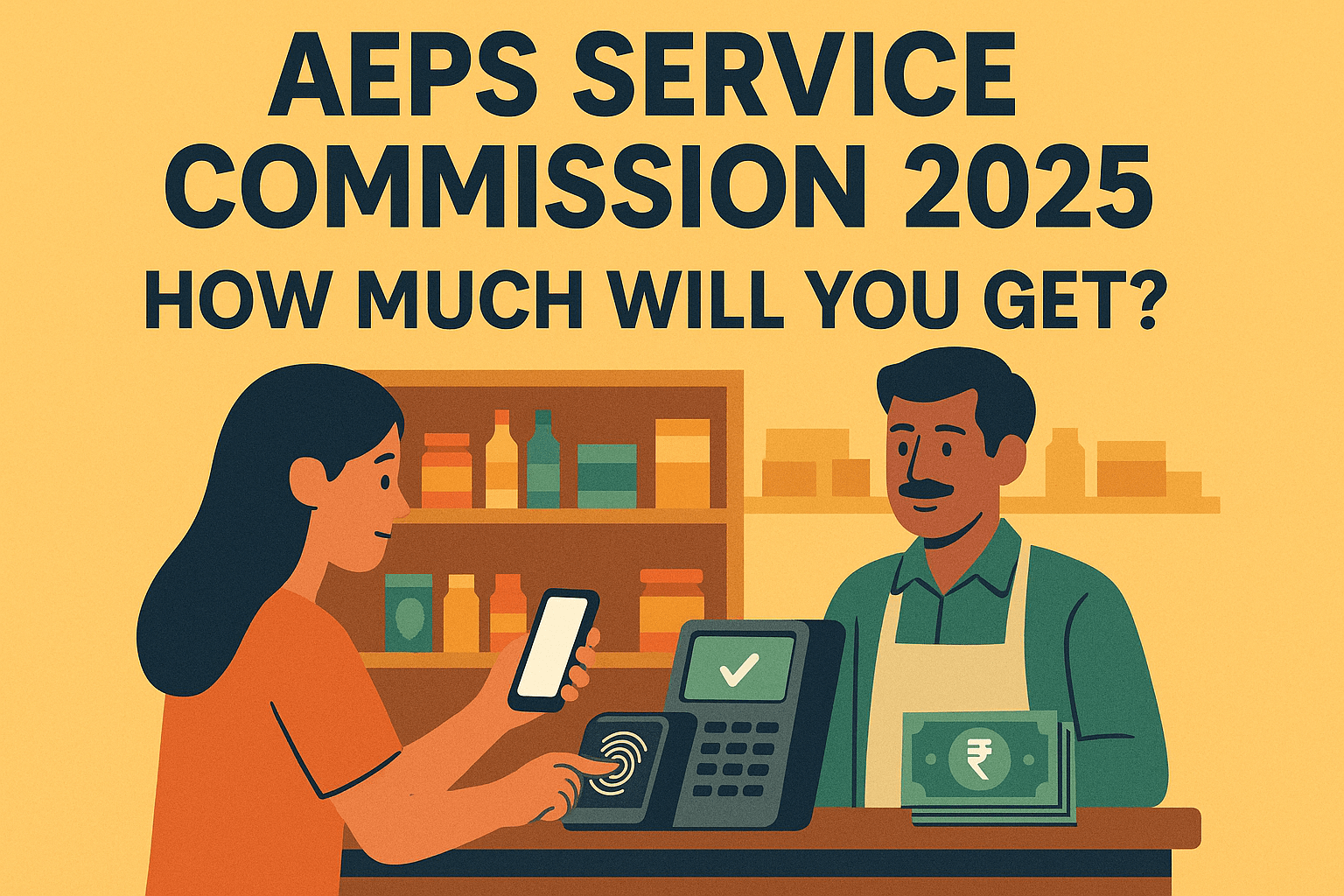Imagine a world where you can walk into a small local shop, not to (AEPS Service Commission 2025) buy groceries, but to withdraw cash from your bank account, deposit money, or check your balance—all without a card, just using your fingerprint. This is the reality for millions of Indians, thanks to the Aadhaar Enabled Payment System (AEPS). But behind every seamless transaction is a business model that incentivizes a vast network of micro-entrepreneurs. If you’re one of them, or are considering becoming one, the burning question is: AEPS Service Commission 2025 – How much will you get? Let’s break it down.
What Exactly is AEPS and How Does it Work?
Before we dive into commissions, it’s crucial to understand the system. AEPS is a bank-led model that allows online financial transactions at Point-of-Sale (PoS) or Micro-ATM devices through a Business Correspondent (BC), commonly known as a Customer Service Point (CSP), using Aadhaar authentication.
In simple terms, you are a mini-ATM. A customer provides:
-
Their Aadhaar number.
-
Their bank’s name (IIN).
-
Their fingerprint (biometric authentication).
You process this request through your AEPS machine, and the transaction is completed. The core services offered are:
-
Cash Withdrawal
-
Cash Deposit
-
Balance Inquiry
-
Aadhaar to Aadhaar Fund Transfer

The Heart of the Matter: Understanding AEPS Commission Structure
The AEPS Service Commission is the fee you earn for facilitating these transactions. It’s not a fixed government-mandated salary; it’s a variable incentive set by the banks and the BC companies that you partner with.
Think of it like this: Banks save a massive amount of money by not having to set up a physical branch in every village. Instead, they pay you a small commission for being their last-mile touchpoint. This commission is typically a percentage of the transaction value or a flat fee, depending on the service.
Here’s a standard breakdown of the commission structure you can expect in 2025 (though exact numbers can vary):
| Service | Typical Commission Range (2025 Projection) | How it’s Usually Applied |
|---|---|---|
| Cash Withdrawal | 0.4% – 0.65% of the transaction value | For a ₹1,000 withdrawal, you earn ₹4 to ₹6.5 |
| Cash Deposit | 0.4% – 0.65% of the transaction value | For a ₹2,000 deposit, you earn ₹8 to ₹13 |
| Balance Inquiry | ₹ 3 – ₹ 7 (Flat Fee) | A fixed fee per inquiry, regardless of the balance |
| Aadhaar to Aadhaar Transfer | 0.25% – 0.4% of the transaction value | For a ₹500 transfer, you earn ₹1.25 to ₹2 |
Source: This data is compiled from publicly available BC agent agreements from major banks like State Bank of India (SBI), Punjab National Bank (PNB), and leading BC companies like Fino Payments Bank and Spice Money.
Factors That Influence Your Final AEPS Commission in 2025
Your exact earnings from the AEPS Service Commission won’t be identical to every other agent. Several factors come into play:
-
Your Banking Partner (BC Company): This is the biggest variable. Different BC companies offer different commission slabs. Some might offer a higher percentage on withdrawals but a lower flat fee on inquiries. It’s essential to compare offers before signing up.
-
Your Location: Agents in remote, rural areas with limited banking infrastructure might be offered slightly higher incentives to encourage their services. Urban agents might see more transactions but potentially at a more competitive rate.
-
Volume of Transactions: This is the golden rule. Your total earnings are a direct product of
(Number of Transactions) x (Commission per Transaction). A high-footfall location like a busy kirana store will naturally generate more revenue than a quieter, home-based setup. -
Type of Transactions: While balance inquiries are frequent, they pay less. Your major income will come from cash withdrawal and deposit transactions, which involve larger amounts of money.
-
Additional Services: Many agents don’t just offer AEPS. They combine it with other services like bill payments, insurance, mutual funds, or recharges. These add-ons significantly boost overall income.
A Realistic Income Calculation: How Much Can You Actually Earn?
Let’s create a practical scenario for an AEPS agent in 2025:
-
Transactions per day:
-
Cash Withdrawal: 15 transactions (avg. ₹2,000 per transaction) = ₹30,000 volume
-
Cash Deposit: 5 transactions (avg. ₹3,000 per transaction) = ₹15,000 volume
-
Balance Inquiry: 20 transactions
-
-
Commission Assumptions:
-
Withdrawal Commission: 0.5%
-
Deposit Commission: 0.5%
-
Balance Inquiry: ₹5 per inquiry
-
-
Daily Earnings Calculation:
-
From Withdrawals: 0.5% of ₹30,000 = ₹150
-
From Deposits: 0.5% of ₹15,000 = ₹75
-
From Balance Inquiries: 20 x ₹5 = ₹100
-
Total Daily Earnings = ₹150 + ₹75 + ₹100 = ₹325
-
-
Monthly Earnings (26 working days): ₹325 x 26 = ₹8,450
This ₹8,450 is your gross commission from core AEPS services. As you can see, it’s a modest income that heavily relies on volume. This is why it’s a popular side business for shop owners rather than a primary standalone business for many. Adding other services can easily push a diligent agent’s earnings well over ₹15,000 – ₹20,000 per month.
How to Maximize Your AEPS Commission Earnings
If you want to increase your take-home pay, you need to be strategic:
-
Choose the Right BC Partner: Research. Don’t just go for the first company you see. Compare their commission rates, technology support (is their app stable?), and additional service offerings.
-
Location is Key: Set up your outlet in a high-traffic area—near a market, bus stand, or in a densely populated colony.
-
Provide Excellent Service: Be patient, helpful, and reliable. A good reputation will bring customers back and encourage word-of-mouth marketing.
-
Diversify Your Services: Don’t rely solely on AEPS. Offer mobile recharges, DTH payments, insurance, PAN card applications, etc. This makes you a one-stop financial shop.
-
Promote Your Outlet: Use simple signage like “Cash Withdrawal and Deposit Available Here.” Inform your existing customers about the new services.

The Future of AEPS and Commissions in 2025
The trend towards digital financial inclusion is only growing. The Government of India and the Reserve Bank of India (RBI) continue to push for deeper penetration of banking services in rural India. This means the AEPS network is set to expand.
While the commission percentages are unlikely to see a dramatic increase due to intense competition, the overall volume of transactions is predicted to rise. The rise of Direct Benefit Transfer (DBT) for schemes like PM-KISAN ensures a steady flow of money into beneficiary accounts, which they will need to withdraw—often through agents like you.
### Frequently Asked Questions (FAQs)
1. Is there any minimum balance or investment required to become an AEPS agent?
Yes, most BC companies require you to maintain a floating cash balance to facilitate transactions. This can range from ₹10,000 to ₹50,000, depending on your expected transaction volume. There might also be a small one-time fee for the KYC process and setting up your ID.
2. What are the risks involved?
The primary risk is cash handling and management. You are responsible for the cash in your drawer. There’s also a minimal risk of transaction failures where money might get debited from a customer’s account but not dispensed by you. A good BC company will have a robust grievance redressal mechanism for such cases.
3. Can I work with multiple BC companies?
Technically, yes. You can have devices or apps from multiple providers. This allows you to offer customers access to more banks and potentially tap into different commission structures. However, it also means managing multiple cash floats and apps.
4. How and when do I receive my commission?
The commission earned is typically credited to your agent account automatically. You can then transfer it to your linked bank account. Most companies settle commissions on a daily or weekly basis.
5. Are AEPS transactions secure?
Extremely. The transaction is authorized only by a successful biometric (fingerprint/iris) authentication from UIDAI. This makes it more secure than a PIN that can be forgotten or stolen.
Conclusion: A Gateway to Financial Entrepreneurship
So, AEPS Service Commission 2025 – How much will you get? The answer is: it’s in your hands. While the commission per transaction is small, the power of volume and diversification can make it a sustainable and profitable venture. It’s a low-investment business model that plays a crucial role in India’s economic fabric, providing both a valuable service to your community and a steady stream of income for you. If you’re looking for a business with a strong social impact and measurable financial returns, becoming an AEPS agent is a compelling choice for 2025 and beyond.
Disclaimer: This article is for educational and informational purposes only. The commission rates and projections mentioned are based on current market analysis and are subject to change based on policies of individual banks and BC companies. We do not guarantee any specific earnings. The figures are provided as examples only. If you have any concerns about the content published, please contact us through our designated DMCA page for content removal requests and verification procedures.
